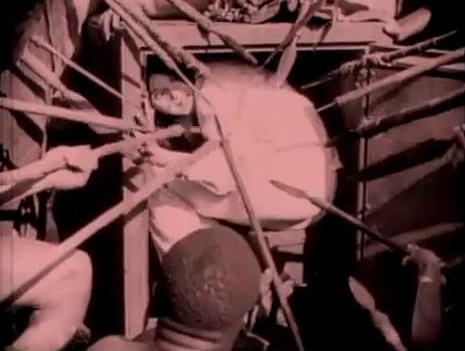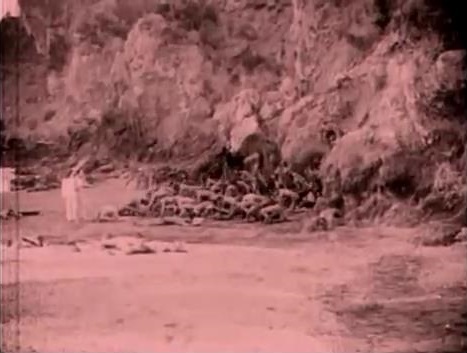Terror
Island

Untold wealth
sank without a trace in the Great War, Houdini as Harry Harper proposes to
administer it via submarine to
“little waifs everywhere—like those two out there” selling
newspapers.
A
work of supreme genius.
Someone else has
an interest in the proceeds (cp. Beyond
the Poseidon Adventure, dir. Irwin Allen). Eugene
Pallette as Guy Mordaunt
double-crosses his old man Job for them, no less.
Question
of human sacrifice, a pearl “stolen from the tribe’s idol”
(cp. Haldane of the Secret Service, dir. Houdini). Faux fire reveals the gem (cf. “The Case of the Blushing Pearls” for Perry Mason, dir. Richard Whorf), but
Lila Lee makes off on horseback.

A reel or two is
missing. Compensatory sacrifice is a feature of Ludwig’s Wake of the Red Witch, see also Ustinov’s Vice Versa. Naturally all this reflects
upon King Solomon’s Mines
(dirs. Stevenson, Bennett & Marton, or Thompson).
A
thrilling demonstration by the escape artist, “world-famous for his exploits
as a self-liberator.”
A girl locked in
a safe at spearpoint, chucked in the sea, Mordaunt has it rigged with dynamite, Harper ventures out
through his submarine’s airlock, the latest thing, and returns a few
minutes later to fend off a deep-sea diver and fetch up the diamonds. Finally
it is clear who is holding who hostage for the wealth, and that completes the
image.
“To the
superstitious natives the reappearance of their two victims rising from the sea,
is nothing short of a miracle,” the one described by Elizabeth Bishop in “Suicide
of a Moderate Dictator” with reference to contemporary events in Brazil
happily foreseen by Capra in Mr. Smith
Goes to Washington (cp. The Story of Jacob and Joseph, dir. Michael Cacoyannis).

The
Covered Wagon
The two paths,
Californy and Oregon, are later analyzed in The Wrong Road.
The plow is the
main image, reviled by hostile Indians, abandoned by gold-seekers, planted in
the snowy ground of Oregon by a pioneer.
Cruze takes upon
himself the visual manner of presentation, it is not filmed correctly (for
that, see Raoul Walsh’s The Big Trail) but according to the lights
of George Catlin, an altogether different proposition.
Therefore these
are true images of the westward journey, still more, a true way of seeing.
None of these
points has ever been grasped by reviewers, who nonetheless acknowledge the
grandeur or sweep or expansiveness and some if not all of the acting.
Two reels’
worth of the original twelve has been trimmed over the years, evidently, and
the prairie fire is nowhere to be seen.
The Great Gabbo
“Averroes’
Search”, one of the Ficciones Borges wrote later, is certainly a
key to this film and to the inability of critics from its premiere until the
present to have any idea why, for example, it contains musical numbers (which
appear well-known to Russell and Powell & Pressburger in The Boy Friend
and The Tales of Hoffmann). No wonder these Multicolor sequences are
nowadays rendered in black-and-white, though half the picture is expressed by
them in fulsome terms, the Broadway show as pagan love ritual and just the
thing Eliot was looking for in The Rite of Spring.
Opposed to this,
the other half of the picture, the Greek drama and its second actor,
represented by the ventriloquist Gabbo and his dummy Otto.
The game is
played quite gentlemanly, Broadway gets a full revue advantageously filmed
onstage, “350 people” tap and sing, the ballet is nonpareil, while
the Great Gabbo gets the Stroheim treatment in his act. The picture is signed
by Ben Hecht in the story department, he of the subtlest mind in pictures.
I Cover the Waterfront
One of those
newspaper reporters (two actually), drawn from life, who write bunk and bilge
for a living but very occasionally trace down a good story.
Three top
reviewers couldn’t see it for beans, Graham Greene did best, Variety
ran a poor second, Mordaunt Hall of the New York Times deplores “one
of those newspaper geniuses to be found only in motion pictures”.
Tony Richardson
absorbed it for The Border, Fritz Lang echoed it in Clash by Night.
The peculiar
notes of the West Coast probably caught critics unaware.
The smuggling
trade, a Chink in the drink, a Spanish prison hulk with torture implements
(Lyon and Colbert take the 25¢ tour memorably), the great shark hunt, a Chinese
coat for the lady, the exposé, no more back to Vermont or on to Singapore.
A great film
pitiably disregarded. “Somebody’s got to do the
washing.”
The Wrong Road
The advantage of
stealing is you don’t have to work, you have a lot more right away than
if you worked for it, a prison sentence is your way of earning it, that’s
all.
So reason the young
couple not long out of college, he (Richard Cromwell) should have been a
well-paid engineer by now, she (Helen Mack) a member of society.
A detective from
the bonding company (Lionel Atwill) gets them paroled after two years of ten,
the money they’ve purloined is still in her music box but Uncle
Bill’s Antique Shop is closed, the thing auctioned, a fellow ex-convict
wants the dough, they can’t get married until their parole ends.
It just
isn’t worth it, they finally resolve, and give back the money from the
bank where he was a teller put on two-weeks’ notice so a relative could
be hired, that sort of establishment.
The crime is laid
out in the droll opening scene at a swanky nightspot, Club Cubanola.